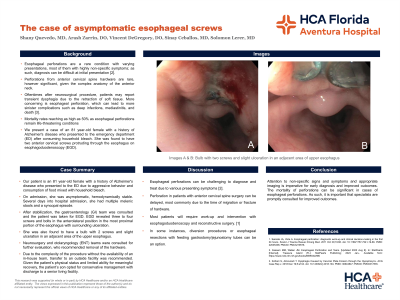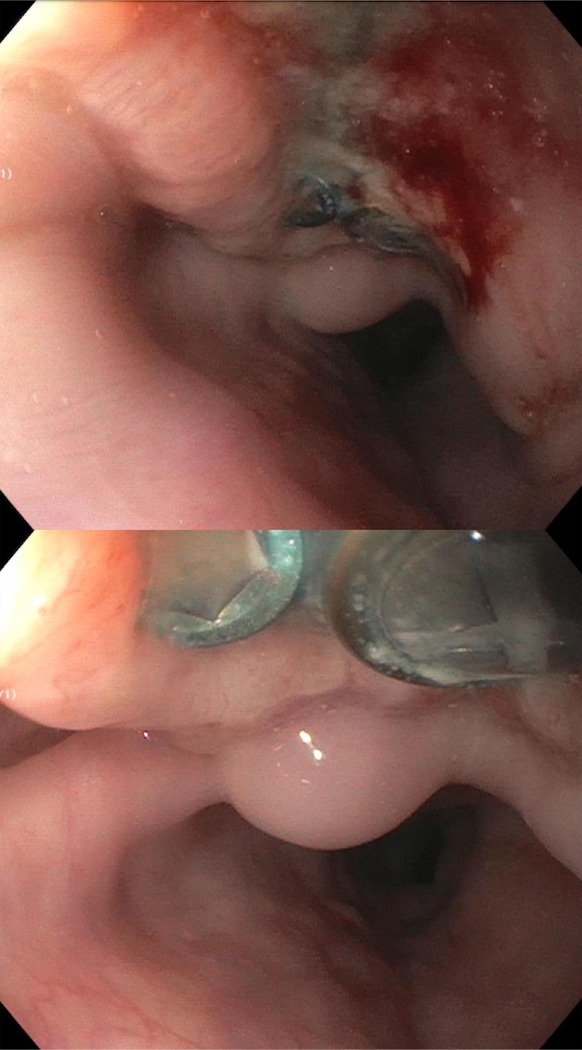Tuesday Poster Session
Category: Esophagus
P3287 - The Case of Asymptomatic Esophageal Screws
Tuesday, October 24, 2023
10:30 AM - 4:00 PM PT
Location: Exhibit Hall

Has Audio

Shany M. Quevedo, MD
HCA East Florida Division
Aventura, FL
Presenting Author(s)
Award: Presidential Poster Award
Shany M.. Quevedo, MD1, Arash Zarrin, DO1, Sinay Ceballos, MD2, Solomon Lerer, MD1
1HCA East Florida Division, Aventura, FL; 2HCA Aventura Hospital & Medical Center, Miami, FL
Introduction: Esophageal perforations are a rare condition with varying presentations; as such, diagnosis can be difficult at initial presentation [2]. Perforations from anterior cervical spine hardware are rare, however significant, given the complex anatomy of the anterior neck. Oftentimes after neurosurgical procedure, patients may report transient dysphagia due to the retraction of soft tissue. More concerning is esophageal perforation, which can lead to more sinister complications such as deep infections, mediastinitis, and death [3]. We present a case of an 81 year-old female with a history of Alzheimer's disease who presented to the emergency department (ED) after consuming household bleach. She was found to have two anterior cervical screws protruding through the esophagus on esophagoduodenoscopy (EGD).
Case Description/Methods: Our patient is an 81 year-old female with a history of Alzheimer's disease who presented to the ED due to aggressive behavior and consumption of food mixed with household bleach. On admission, she was asymptomatic, hemodynamically stable. Several days into hospital admission, she had multiple melenic stools and a syncopal episode. After stabilization, the gastroenterology (GI) team was consulted and the patient was taken for EGD. EGD revealed three to four screws and bolts in the anterolateral position in the most proximal portion of the esophagus with surrounding ulceration. Additionally, she was found to have a bulb with 2 screws and slight ulceration in an adjacent area of the upper esophagus. The neurosurgery and otolaryngology (ENT) teams were consulted for further evaluation, who recommended removal of the hardware. Due to the complexity of the procedure without the availability of an in-house team, transfer to an outside facility was recommended. Given the patient’s physical status and limited ability for meaningful recovery, the patient’s son opted for conservative management with discharge to a senior living facility.
Discussion: Esophageal perforations can be challenging to diagnose and treat due to various presenting symptoms [2]. Perforation in patients with anterior cervical spine surgery can be delayed, most commonly due to the time of migration or fracture of hardware. Most patients will require work-up and intervention with esophagoduodenoscopy and reconstructive surgery; however, it may not be the best option for all patients. Attention to non-specific signs and symptoms and appropriate imaging is imperative for early diagnosis and improved outcomes [1].

Disclosures:
Shany M.. Quevedo, MD1, Arash Zarrin, DO1, Sinay Ceballos, MD2, Solomon Lerer, MD1. P3287 - The Case of Asymptomatic Esophageal Screws, ACG 2023 Annual Scientific Meeting Abstracts. Vancouver, BC, Canada: American College of Gastroenterology.
Shany M.. Quevedo, MD1, Arash Zarrin, DO1, Sinay Ceballos, MD2, Solomon Lerer, MD1
1HCA East Florida Division, Aventura, FL; 2HCA Aventura Hospital & Medical Center, Miami, FL
Introduction: Esophageal perforations are a rare condition with varying presentations; as such, diagnosis can be difficult at initial presentation [2]. Perforations from anterior cervical spine hardware are rare, however significant, given the complex anatomy of the anterior neck. Oftentimes after neurosurgical procedure, patients may report transient dysphagia due to the retraction of soft tissue. More concerning is esophageal perforation, which can lead to more sinister complications such as deep infections, mediastinitis, and death [3]. We present a case of an 81 year-old female with a history of Alzheimer's disease who presented to the emergency department (ED) after consuming household bleach. She was found to have two anterior cervical screws protruding through the esophagus on esophagoduodenoscopy (EGD).
Case Description/Methods: Our patient is an 81 year-old female with a history of Alzheimer's disease who presented to the ED due to aggressive behavior and consumption of food mixed with household bleach. On admission, she was asymptomatic, hemodynamically stable. Several days into hospital admission, she had multiple melenic stools and a syncopal episode. After stabilization, the gastroenterology (GI) team was consulted and the patient was taken for EGD. EGD revealed three to four screws and bolts in the anterolateral position in the most proximal portion of the esophagus with surrounding ulceration. Additionally, she was found to have a bulb with 2 screws and slight ulceration in an adjacent area of the upper esophagus. The neurosurgery and otolaryngology (ENT) teams were consulted for further evaluation, who recommended removal of the hardware. Due to the complexity of the procedure without the availability of an in-house team, transfer to an outside facility was recommended. Given the patient’s physical status and limited ability for meaningful recovery, the patient’s son opted for conservative management with discharge to a senior living facility.
Discussion: Esophageal perforations can be challenging to diagnose and treat due to various presenting symptoms [2]. Perforation in patients with anterior cervical spine surgery can be delayed, most commonly due to the time of migration or fracture of hardware. Most patients will require work-up and intervention with esophagoduodenoscopy and reconstructive surgery; however, it may not be the best option for all patients. Attention to non-specific signs and symptoms and appropriate imaging is imperative for early diagnosis and improved outcomes [1].

Figure: Esophageal Screws
Disclosures:
Shany Quevedo indicated no relevant financial relationships.
Arash Zarrin indicated no relevant financial relationships.
Sinay Ceballos indicated no relevant financial relationships.
Solomon Lerer indicated no relevant financial relationships.
Shany M.. Quevedo, MD1, Arash Zarrin, DO1, Sinay Ceballos, MD2, Solomon Lerer, MD1. P3287 - The Case of Asymptomatic Esophageal Screws, ACG 2023 Annual Scientific Meeting Abstracts. Vancouver, BC, Canada: American College of Gastroenterology.

